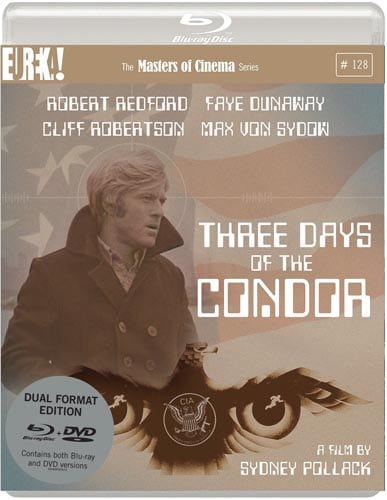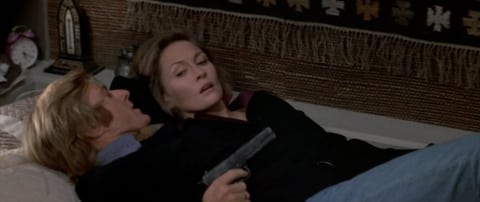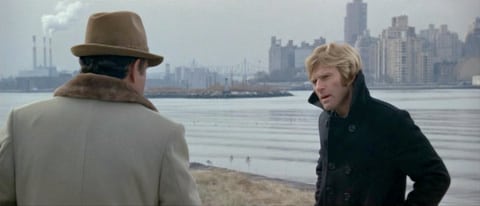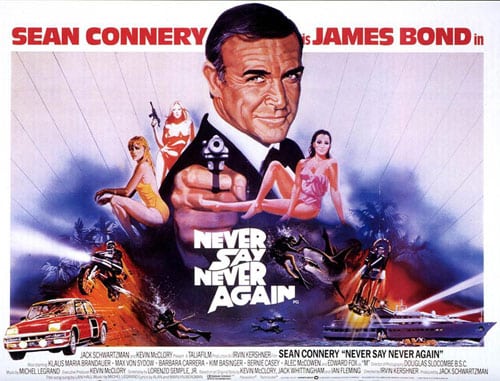Three Days of the Condor (1975)
Directed by: Sydney Pollack
Written by: David Rayfiel, James Grady, Lorenzo Semple Jr
Starring: Cliff Robertson, Faye Dunaway, Max von Sydow, Robert Redford
USA
AVAILABLE ON DUAL FORMAT BLU-RAY AND DVD: 11TH APRIL, from EUREKA ENTERTAINMENT
RUNNING TIME: 116 min
REVIEWED BY: Dr Lenera, Official HCF Critic
Joe Turner, code name “Condor”, is a CIA analyst who works in a clandestine office in New York City, which fronts as the “American Literary Historical Society”, and whose job is to read books, newspapers, and magazines from around the world, looking for codes and messages. One day, he files a report to CIA headquarters on a poorly selling novel which has been translated into Spanish, Dutch and Arabic. His co-workers in his office are murdered while he’s out, and after returning to find six corpses, Turner calls headquarters and is asked to meet his Head of Department Wicks, but Wicks tries to kill him. Turner goes on the run….
I’d seen Three Days Of The Condor once before prior to watching it for this review, but didn’t remember much about it except that it was fairly entertaining but not really anything special. The film carries with it the reputation as a classic of the conspiracy thriller kind, and it is certainly absorbing as well as being just as believable when seen today as it must have been in 1975; in fact one thing that is noteworthy about it is that it hasn’t really dated aside from some of the fashions and the lack of digital technology. However, it don’t think that it quite deserves its reputation. It’s full of good ingredients but in the end is slightly less than the sum of its parts. This is not of course to say that it’s a bad movie; far from it. That smooth craftsman Sydney Pollack [probably best known for The Firm, The Way We Were and Out Of Africa, though I feel that his two best films are the slightly more offbeat The Yakuza and They Shoot Horses Don’t They?] was incapable of making such a thing, and there is still a lot to appreciate and enjoy, hence the [still reasonably high] star rating that I’ve given it, but to me Three Days Of The Condor was just a bit underwhelming considering how well it’s generally thought of.
Peter Yates was actually originally signed to direct the film when Dino De Laurentiis planned for Warren Beatty to star. When Beatty left for undisclosed reasons, Redford took his place, and asked for Pollack, with whom he’d worked with twice before, as director, so De Laurentiis paid Yates his full $200k salary not to helm the picture. James Grady’s 1974 novel Six Days Of The Condor, which in 1978 led to a sequel Shadow Of The Condor, was much shortened and simplified, and the villain’s motivations changed from drug running greed to something more vague and far shadier. The film was shot on location in New York City, New Jersey, and Washington DC, and, because it was shot in autumn but was set in winter, on the streets where the movie was being filmed, saplings had to be defoliated and leaves removed from the trees, to create the necessary wintry look. Released soon after several cases of CIA corruption, the film was a critical and commercial success, but for some reason was never released in the UK on any form of home media until….well….now. In 1991, Pollack brought a lawsuit against Danish TV after screening the film in pan-and-scan in 1991. The court ruled that the pan scanning conducted by Danish television was a ‘mutilation’ of the film and a violation of Pollacks ‘Droit Moral’, his legal right as an artist to maintain his reputation by protecting the integrity of his work, but Pollack lost the case on a technicality.
One thing I liked very much about Three Days Of The Condor right from the offset is how vague it is about many details, something which can help a film like this, and which was obviously a deliberate decision. For a start, it’s not made terribly clear as to what our hero and his soon-to-be-dead colleagues do exactly. Something about trawling through books and magazines looking for messages and codes which are then fed into a computer. It doesn’t matter at all. Pollack builds the suspense nicely with repeated shots of a man in a raincoat watching the office, and Turner leaving, whilst inside a phonebooth. The ensuring massacre [which I believe was cut out of the version I’d seen on TV those many years ago so the film could be shown at 8 in the evening] has quite an impact because of the matter-of-fact way it’s presented, and, when Turner comes back from lunch to find the dead bodies, the sound of information being fed into the computer creates a rather eerie background noise. It’s a really great opening act for the film and when Turner goes on the run while trying to set up a meeting with his boss, we are very worried for him because, as he says: “I’m not a field agent, I just read books”.
It’s revealed to us very early on that a portion of the CIA is out to get Turner, usually in various meetings which are interesting and quietly chilling as people calmly but coldly discuss murder and various other “contingency plans”. Some of this dialogue plays over shots of Turner, which increases the feeling of danger, and it’s all very engrossing. Repeated shots of the World Trade Centre add their own rather ghostly presence. However, rather than gradually ramping up the sense of paranoia which is what I felt the film was going to do, its grip starts to relax and after a while I wasn’t on the edge of my seat enough, nor anxious enough, as I should have been. I certainly don’t believe that plentiful action is necessary for a film like this, and I can only admire the way the film climaxes with two lengthy dialogue scenes, dialogue scenes which also only really scratch the surface of what is going on, in a film that was clearly made for adults who don’t require everything to be spelled out. I just felt that it didn’t quite hit the target overall though, and in fact it was individual scenes and small details, some of which have an Hitchcockian feel, that were more memorable for me, like Turner visiting a dead man’s apartment and finding his wife preparing her husband’s dinner, Turner blaring soul music from a stereo to get the edge on his quarry, Turner and contract killer Joubert both being in a lift where Turner obviously thinks Joubert may be suspicious and Joubert certainly know who Joubert is, a postman [who is actually an assassin] whose pen doesn’t work. The latter moment leads to a pretty good fight scene in an apartment where bookworm Turner cleverly uses his environment to get the edge on his opponent.
The apartment the above scene occurs in belongs to Kathy Hale, the film’s love interest who seems to have been clumsily shoehorned into the narrative. Turner holds a gun to her, ties her up, gags her and keeps her prisoner in her home, then, in an especially poorly written scene [well, I suppose it might have worked if it featured James Bond] suddenly makes a pass at her and they have sex, which is utterly gratuitous and highly ridiculous, except that audiences at the time would have expected two of the screen’s sexiest stars to “get it on” at some point during the film. It would have worked much better if this had happened somewhat later on in the narrative. At least the very final scene truly impresses with the way that it bravely seems to stop a minute or so before you think it’s going to, and I can’t imagine this would be the case if the film were made today. Turner tells the main bad guy that something’s going to happen which will tip the balance just a bit on the side of the good guys. Most films would show us the event and send the viewer away happy that some comeuppance has occurred, even if the overall vibe is still a relatively downbeat one. This one just leaves us to guess whether it will happen or not. My guess is no, but then I’m usually more of a “glass half empty” than a “glass half full” person.
Pollack, a good example of the kind of filmmaker who may sadly have trouble flourishing in today superhero-dominated climate, doesn’t direct with a whole lot of style, aside from a jump cut-filled sex scene which edits in shots of the heroine’s paintings, but still steers the film with breezy confidence. Cinematographer Owen Roizman’s work is mostly naturalistic but does give us the odd beauty like a truly lovely close-up shot of Turner and Catty, his head and her face back-lit and her mouth beautifully illuminated by the sun streaming in. Redford for me doesn’t project enough vulnerability in his role though is still fine overall, while Faye Dunaway, who rarely looked more stunning, does her best in what truly is a terribly scripted part. A special mention must go to Max Von Sydow as the killer Joubert, projecting menace, determination but also just a touch or two of vulnerability in a typically perfectly judged and highly detailed performance from this great actor. The film uses very little score, Dave Grusin’s jazzy work only occasionally making itself known, let alone coming to the fore. Pollack must have really liked Mozart’s Concerto for clarinet and orchestra in A, as it also turned up in Out Of Africa. Well crafted in many respects as well as being a film that may not just make you think but may make you very worried about the organisations that supposedly protect our country, Three Days Of The Condor has its flaws – the more I think about it, certain aspects of the overall plot aren’t so much ambiguous as just very flimsy – but is still overall a good watch and a worthwhile purchase if you’re a fan of thrillers of the talkier and murkier kind.
Rating: 









Three Days Of The Condor’s debut UK home media release is in a superb restoration which is well up to Eureka Entertainment’s high standards. That traditionally soft 70’s film look, which often hampers releases of movies from that decade, isn’t so much in evidence and parts of it could have been filmed yesterday. I doubt the film has ever had a better presentation. Special features are a bit minimal; it’s a shame that Eureka obviously couldn’t licence the Pollack commentary and all the featurettes that were on the Region ‘B’ continental release from Studio Canal, but the hour-long look at Pollack’s career is certainly worthwhile and the new video interview quite illuminating.
SPECIAL FEATURES
*New high-definition presentation
*Optional English subtitles for the deaf and hearing impaired
*Stereo and 5.1 soundtrack options
*Exclusive new video interview with film historian Sheldon Hall
*The Directors: Sydney Pollack – A career-spanning appreciation of the director’s works
*Original theatrical trailer
*32-PAGE BOOKLET featuring a new essay on the film by critic Michael Brooke, an extensive interview with Pollack, and archival images







Be the first to comment